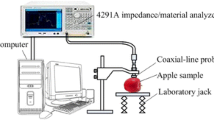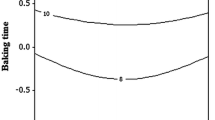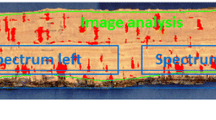Abstract
Dielectric constant (DC) and dielectric loss factor (DLF) are the two principal parameters that determine the coupling and distribution of electromagnetic energy during radiofrequency and microwave processing. In this study, chemometric methods [classical least square (CLS), principle component regression (PCR), partial least square (PLS), and artificial neural networks (ANN)] were investigated for estimation of DC and DLF values of cakes by using porosity, moisture content and main formulation components, fat content, emulsifier type (Purawave™, Lecigran™), and fat replacer type (maltodextrin, Simplesse). Chemometric methods were calibrated firstly using training data set, and then they were tested using test data set to determine estimation capability of the method. Although statistical methods (CLS, PCR and PLS) were not successful for estimation of DC and DLF values, ANN estimated the dielectric properties accurately (R 2, 0.940 for DC and 0.953 for DLF). The variation of DC and DLF of the cakes when the porosity value, moisture content, and formulation components were changed were also visualized using the data predicted by trained network.




Similar content being viewed by others
Abbreviations
- A :
-
Input matrix
- ANN:
-
Artificial neural networks
- b n :
-
Coefficient matrix
- CLS:
-
Classical least-square
- DC:
-
Dielectric constant
- DLF:
-
Dielectric loss factor
- MSE:
-
Mean square error
- n −1 :
-
Inverse of matrix n
- n T :
-
Transpose of matrix n
- P :
-
Eigenvectors matrix
- PCR:
-
Principle component regression
- PLS:
-
Partial least square
- R 2 :
-
Coefficient of determination values
- T :
-
Score matrix
- W n :
-
Weight vectors
- X 1 :
-
Porosity, %
- X 2 :
-
Moisture content, % (w/w)
- X 3 :
-
Fat content, % (on flour-weight basis)
- X 4 :
-
Purawave, % (on flour-weight basis)
- X 5 :
-
Lecigran, % (on flour-weight basis)
- X 6 :
-
Maltodextrin, % (on flour-weight basis)
- X 7 :
-
Simplesse, % (on flour-weight basis)
References
Baş, D., Dudak, F.-C., & Boyacı, İ.-H. (2007). Modeling and optimization. III. Reaction rate estimation using artificial neural network (ANN) without a kinetic model. Journal of Food Engineering, 79, 622–628.
Calay, R.-K., Newborough, M., Probert, D., & Calay, P.-S. (1995). Predictive equations for dielectric properties of foods. International Journal of Food Science &Technology, 29, 699–713.
Datta, A.-K., Sumnu, G., & Raghavan, G.-S.-V. (2005). Dielectric properties of foods. In M. A. Rao, S. S. H. Rizvi, & A. K. Datta (Eds.) Engineering properties of foods ((pp. 501–565)3rd ed.). Boca Raton: CRC Press Taylor & Francis Group.
Du, C.-J., & Sun, D.-W. (2004). Recent developments in the applications of image processing techniques for food quality evaluation. Trends in Food Science and Technology, 15, 230–249.
Feng, H., Tang, J., & Cavalieri, R.-P. (2002). Dielectric properties of dehydrated apples as affected by moisture and temperature. Transaction of the ASAE, 45, 129–135.
Kılıç, K., Boyacı, İ.-H., Köksel, H., & Küsmenoğlu, İ. (2007). A classification system for beans using computer vision system and artificial neural networks. Journal of Food Engineering, 78, 897–904.
Kim, Y.-R., Morgan, M.-T., Okos, M.-R., & Stroshine, R.-L. (1988). Measurement and prediction of dielectric properties of biscuit dough at 27 MHz. Journal of Microwave Power Electromagnetic Energy, 33, 184–194.
Lou, W., & Nakai, S. (2001). Application of artificial neural networks for predicting the thermal inactivation of bacteria: A combined effect of temperature, pH and water activity. Food Research International, 34, 573–579.
Reid, L.-M., O’Donnell, C.-P., & Downey, G. (2006). Recent technological advances for the determination of food authenticity. Trends in Food Science & Technology, 17, 344–353.
Palabiyik, I.-M., Dinç, E., & Onur, F. (2004). Simultaneous spectrophotometric determination of pseudoephedrine hydrochloride and ibuprofen in a pharmaceutical preparation using ratio spectra derivative spectrophotometry and multivariate calibration techniques. Journal of Pharmaceutical and Biomedical Analysis, 34, 473–483.
Sakiyan, O., Sumnu, G., Sahin, S., & Meda, V. (2007). Investigation of dielectric properties of different cake formulations during microwave and microwave-infrared combination baking. Journal of Food Science, 72, 205–213.
Sumnu, G., Datta, A.-K., Sahin, S., Keskin, S.-O., & Rakesh, V. (2007). Transport and related properties of breads baked using various heating modes. Journal of Food Engineering, 78, 1382–1387.
Sun, E., Datta, A.-K., & Lobo, S. (1995). Composition-based prediction of dielectric properties of foods. Journal of Microwave Power and Electromagnetic Energy, 30, 205–212.
Warnes, M.-R., Glassey, J., Montague, G.-A., & Kara, B. (1998). Application of radial basis function and feedword artificial neural networks to the Eschericia coli fermentation process. Neurocomputing, 20, 67–82.
Author information
Authors and Affiliations
Corresponding author
Rights and permissions
About this article
Cite this article
Boyacı, İ.H., Sumnu, G. & Sakiyan, O. Estimation of Dielectric Properties of Cakes Based on Porosity, Moisture Content, and Formulations Using Statistical Methods and Artificial Neural Networks. Food Bioprocess Technol 2, 353–360 (2009). https://doi.org/10.1007/s11947-008-0064-z
Received:
Accepted:
Published:
Issue Date:
DOI: https://doi.org/10.1007/s11947-008-0064-z




